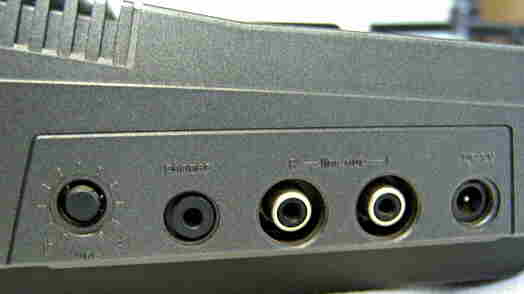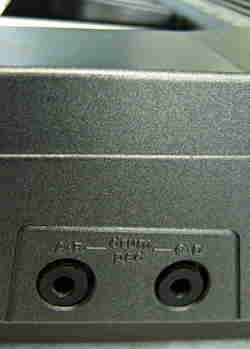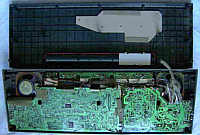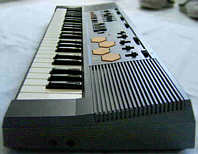CASIO
 |
|
keyboard
with warm timbres, drumpads & versatile accompaniment |
|
|
This keyboard from 1986 (service manual date) was the direct predecessor
of the Casio MT-520. It has quite
warm semi- analogue sound, sample based percussion and 4 rubber drumpads
for "Super Drums" accompaniment.
Most features and the sound engine correspond to the MT-520, but
in opposite to this it has even 20 semi- OBS preset sounds and 4 chord
variations, but only 4 drumpads those each can be switched among 3 preset
sounds. (Alternatively 4 external pads can be connected through 2 stereo
jacks.) The accompaniment sounds warmer than with MT-520.
Important: Very annoying is that the 4 Super Drums
tracks of the rhythm section here can not be muted but only switched among
each 4 variants, which severely limits its usability. Thus do not pay too
much for the Casio MT-500 if you intend to use it as a drum machine.
On eBay people tend to pay crazy prices for this thing while the
MT-520
goes much cheaper and is apparently still considered a toy, despite in
practise its rhythm section far superior; it also has more drumpad inputs
and intro/ ending feature, those all lack on the MT-500.
The original German retail price of the MT-500 in a German Conrad
catalogue from 1988 was 799DM (about 400€). Due to the many similarities
I only describe here the differences to the Casio
MT-520.
different main features:
-
20 semi- OBS preset sounds {piano, vibraphone, flute, human voice, bells,
jazz organ 1, harpsichord, double reed, synth. sound 1, elec. guitar |
elec. piano, violin, panpipe, pipe organ, glockenspiel, jazz organ 2, clavichord,
synth. reed, synth. sound 2, synth. guitar} (selected through 10 locking
OBS buttons + bank switch button)
-
12 semi- OBS preset rhythms {rock, disco, pops 1, swing, samba, march |
slow rock, 16 beat, pops 2, reggae, bossa nova, waltz} (selected through
6 locking OBS buttons + bank switch button)
-
no rhythm intro/ ending feature
-
4 "Super Drums" rhythm variation slide switches {bass drum/ bass, snare
drum/ rim shot/ tom, cymbal/ hihat, hand clap/ agogo/ bongo} (each 4 variations,
no mute)
-
4 accompaniment variations slide switch
-
stepless tempo slider
-
4 rubber drumpads switchable to each 3 sounds (very responsive):
-
bass drum, hand clap, cymbal
-
snare drum, rim shot, agogo
-
open hihat, synth. hi tom, hi bongo
-
closed hihat, synth. lo tom, low bongo
-
no sequencer
-
slightly different percussion samples & less intense stereo chorus.
Some timbres are more squarewave- like (by different filters?). Accompaniment
is warmer, duller and has some sustain.
-
complex multi-chip hardware:
-
accompaniment CPU= "NEC D930G
022, B603HK(?), Japan" (80 pin SMD)
-
main voice sound IC= "NEC D931C
011, 8530KY, Japan" (42 pin DIL, like in Casio
CT-410V)
-
percussion sound IC= "NEC D934G,
8606KK, Japan" (80 pin SMD)
-
accompaniment ROM= "NEC D23C64EC 026, 8605E7, Japan" (28 pin DIL, 8KB,
pinout 27C256 OC)
-
percussion sample ROM= "HN613256P CM4, 6A3, Japan" (28 pin DIL, 32KB)
-
SRAM= "LC3514A, L20 5M8" (18 pin DIL, 0.5KB x 4bit)
-
stereo chorus: BBD= "MN3207, 56" (8 pin DIL, 1024 steps), clock= "MN3102,
5.7" (8 pin DIL)
-
percussion DAC= "Mitsubishi 2064, 611" (16 pin SMD, PCB label "EXK-F19Z,
2064")
-
power amp= "LA4125" (18 pin DIL)
-
DAC hybrid= "HD216AP" (20 pin SIL)
-
only 2 drumpad jacks (3.5mm stereo jacks, for each 2 pads)
 |
 |
modifications:
-
polarity protection diode added, power supply jack polarity corrected.
notes:
In comparison to Casio MT-520 the
case of the MT-500 has no stair step at the lower speaker rim. The electronics
is a very complex multi- chip hardware on 2 large PCBs with many discrete
components.
The sound engine of the preset sounds resembles the MT-520, but the
stereo chorus effect is narrower and most sounds contain less reverb. Many
timbres also sound more squarewave- like - likely by different filters.
I will describe the preset sounds in comparison to MT-520 if present. The
"piano" here sounds a bit more synthetic than on MT-520 and has no sustain,
thus notes stop immediately after key release. The "elec. piano" has a
mild attack, a dose of chorus and long sustain; its timbre resembles more
a sitar than the MT-520 version. "vibraphone" is more percussive, brighter
and octave higher than on MT-520, which makes it more realistic. "violin"
otherwise sounds vs. MT-520 an octave higher, duller (less realistic) and
has some reverb. "flute" is vs. MT-520 an octave higher, more squarewave-
like and has no reverb; thus is it more a wooden recorder flute than a
metal flute. "panpipe" is duller, 1 octave lower and has reverb. "human
voice" is like MT-520 with longer sustain. The "jazz organ 1" resembles
"jazz organ" on MT-520 but sounds more Hammond- like with less buzzy
bass range; it also resembles here a sung "ah". "jazz organ 2" is duller,
a bit thinner and has reverb. "pipe organ" resembles MT-520 but has more
percussive attack. "bells" is a squarewave musicbox timbre with 3Hz vibrato
and a dose of chorus; "glockenspiel" sounds 1 octave lower with sonorous
multipulse bass range. "harpsichord" has much reverb and a 3Hz chorus vibrato
that makes it badly unrealistic; "clavichord" is duller with shorter reverb
(but MT-520 "funky clavi" still sounds more powerful and 1 octave lower).
"double reed" sounds rather like a french horn with chorus vibrato and
much reverb. "synth. reed" is a variant that sounds thinner and thus more
like a trumpet or tenor saxophone. (Unlike expected, both have no similarities
with a reed organ.) "synth. sound 2" resembles a slightly dull sitar with
sustain; 1 is similar but grows duller and thicker during attack like layered
with
a short pipe organ tone with sustain. The "elec. guitar" sounds duller
than MT-520 and has reverb, while "synth. guitar" has a very dry and harsh
buzzing timbre that resembles the MT-520 "funky clavi" but sounds thinner,
has chorus vibrato and reverb. Unlike MT-520, the MT-500 employs real locking
semi- OBS preset sound buttons, those make it easier to see the selected
sound but make them harder to trill them for live play tricks. (Like with
Casio
CT-410V they have no technical reasons since the electronics memorizes
the last pushed button anyway.)
The rhythms employ quite similar woody sample percussion like Casio
CZ-230S (that seems to be based on the Casio RZ-1 drum computer);
e.g. the "handclap" has the same unusual mechanical typewriter timbre,
but the sound set has also differences; e.g. the snare is duller and the
bongos have different pitch (likely by changed sample playback frequency).
The MT-500 percussion samples are different from MT-520; the individual
sounds have changed pitches (some lower, some higher) and also the sample
resolution may be slightly lower because e.g. the cymbal sounds thinner
and the snare duller. Unlike MT-520 the accompaniment sounds include short
sustain and sound warmer, duller and less dry, which gives the bass voice
more pressure. (The bass resembles Casio
MT-800.) The automatic accompaniment algorithm is programmed simpler
than with MT-520; it does not recognize played chords and play different
patterns for them but only inserts the up to 4 notes of pressed keys into
a given pattern (a bit like the archaic Antonelli
Star 2379). Thus the played chord is never split into melody lines
of alternating notes but only chopped as a staccato. But the benefit of
it is that you can not only play any disharmonic non-chords (the MT-520
still could do them) but also rapidly trill multiple accompaniment keys
faster than the pattern plays. And in spite of the simple algorithm the
available patterns are still reasonably complex (partly contain arpeggios,
walking bass lines etc.) and you can manually switch between 4 accompaniment
variations per rhythm. Instead of intro and ending there is only a fill-in
pattern (with accompaniment) for each rhythm.
Very annoying is that the individual percussion tracks of the "Super
Drums" can not be muted individually. Touching any drumpad mutes the rhythm
until any key in chord section is pressed; the "bass drum pattern" switch
determined whether the base drum of the rhythm stays audible or mutes also.
(Unlike MT-520 the "casio chord" switch doesn't disturb running rhythms
here.) Each of the 4 drumpads can be quickly switched to 3 different percussion
samples; despite this way 12 sounds in total can be played, the 8 fixed
OBS drumpads of the MT-520 are more fun to play. The Super Drums concept
and algorithm is described in US patents 4757736 and 4972755.
hardware details
The Casio MT-500 is a far relative of the MT-65 hardware family (see Casio
CT-410V). While the main voice sound IC "NEC D931C
011" is the identical, the accompaniment CPU "NEC D930G
022" has a different software number and controls the additional percussion
IC NEC D934G with the
help of 32KB percussion sample ROM "HN613256P CM4" and 8KB accompaniment
ROM "NEC D23C64EC 026" (I dumped them). There is also a 4 bit SRAM "LC3514A"
(0.5KB) for sequencer and a stereo chorus (single BBD line with emphasis).

The electronics is a very complex multi-chip hardware on 2 large PCBs with
many discrete components. The percussion rom is only connected to the D934G
and does not communicate with the D930G CPU. Because the CPU data bus is
only 4 bit wide, the 8 bit data from the accompaniment rom are split in
a TC74HC257 and the active nibble is selected through address line A13
on CPU pin 73. With ROM D23C64EC removed, everything else works (including
drum pads and chords) but lacks rhythm and accompaniment. With ROM HN613256P
removed, everything else works, but all percussion turns into random digital
noise. So it may be possible to replace the percussion samples and possibly
accompaniment patterns by installing 27C256 eproms (with diodes in data
lines) instead of these roms.
Trimmer VR1 is bit compensation for linearity of the main voice DAC
(select 'vibraphone' and play a midrange note to adjust). VR (50k) changes
the stereo chorus LFO speed (default 1s +/- 20% at pin 7 of op-amp "4558
(4)").
A fixed lowpass filter (similar but not identical with MT-65) modifies
the main voice timbre. These are the filter switch outputs of the D930
CPU shown in MT-500 service manual.
|
preset sound:
|
IO-1 (F1)
|
IO-2 (F2) |
IO-3 (F3) |
| piano |
H
|
H
|
H
|
| vibraphone |
|
|
H
|
| flute |
H
|
|
H
|
| human voice |
H
|
H
|
H
|
| bells |
|
|
|
| jazz organ 1 |
|
H
|
H
|
| harpsichord |
|
|
|
| double reed |
|
H
|
H
|
| synth. sound 1 |
|
|
|
| electric guitar |
|
|
|
| electric piano |
|
|
|
| violin |
|
|
|
| pan-pipe |
H
|
H
|
H
|
| pipe organ |
|
|
|
| glockenspiel |
|
|
|
| jazz organ 2 |
|
H
|
H
|
| clavi chord |
|
|
|
| synth. reed |
|
|
|
| synth. sound 2 |
|
|
|
| synth. guitar |
|
|
H
|
|
The chord voice has a fixed filter with sustain. These are the combinations
of rhythm and chord switch.
|
preset rhythm: | chord ->
|
I
|
II |
III |
IV |
| rock |
3
|
4
|
3
|
3
|
| disco |
3
|
3
|
3
|
3
|
| pops 1 |
4
|
3
|
3
|
3
|
| swing |
1
|
3
|
1
|
3
|
| samba |
4
|
4
|
3
|
4
|
| march |
4
|
4
|
4
|
1
|
| slow rock |
3
|
3
|
3
|
1
|
| 16 beat |
4
|
3
|
4
|
4
|
| pops 2 |
1
|
3
|
3
|
1
|
| reggae |
4
|
4
|
3
|
4
|
| bossanova |
1
|
3
|
3
|
3
|
| waltz |
1
|
3
|
3
|
3
|
|
combination:
|
filter
|
sustain
|
| 1 |
close
|
on
|
| 2 |
close
|
|
| 3 |
open
|
on
|
| 4 |
open
|
|
|
keyboard matrix
I haven't analyzed this keyboard matrix by myself, but only read the MT-500
service manual, thus there may be still unknown eastereggs (due to strong
similarities with MT-65 hardware see CT-410V).
Locking switches were found in schematics.
|
51 KI1
|
50 KI2
|
49 KI3
|
48 KI4
|
47 KI5
|
46 KI6
|
45 KI7
|
44 KI8
|
|
CPU pin
|
|
in 1
|
in 2
|
in 3
|
in 4
|
in 5
|
in 6
|
in 7
|
in 8
|
in / out
|
|
o
C1
|
o
C#1
|
o
D1
|
o
D#1
|
o
E1
|
o
F1
|
|
|
out 1
|
52 KC1
|
o
F#1
|
o
G1
|
o
G#1
|
o
A1
|
o
A#1
|
o
B1
|
|
|
out 2
|
53 KC2
|
o
C2
|
o
C#2
|
o
D2
|
o
D#2
|
o
E2
|
o
F2
|
C.
casio
|
C.
fingered
|
out 3
|
54 KC3
|
o
F#2
|
o
G2
|
o
G#2
|
o
A2
|
o
A#2
|
o
B2
|
|
|
out 4
|
55 KC4
|
o
C3
|
o
C#3
|
o
D3
|
o
D#3
|
o
E3
|
o
F3
|
P.
select A
handclap
|
P.
select A
cymbal
|
out 5
|
56 KC5
|
o
F#3
|
o
G3
|
o
G#3
|
o
A3
|
o
A#3
|
o
B3
|
P.
select B
rimshot
|
P.
select B
agogo
|
out 6
|
57 KC6
|
o
C4
|
o
C#4
|
o
D4
|
o
D#4
|
o
E4
|
o
F4
|
P.
select C
synt. hi tom
|
P.
select C
hi bongo
|
out 7
|
58 KC7
|
o
F#4
|
o
G4
|
o
G#4
|
o
A4
|
o
A#4
|
o
B4
|
P.
select D
synth. lo tom
|
P.
select D
lo bongo
|
out 8
|
59 KC8
|
o
C5
|
|
R.
start/stop
|
R.
synchro/fill-in
|
|
|
R.
base pattern
|
|
out 9
|
60 KC9
|
O.
piano
|
O.
vibraphone
|
O.
flute
|
O.
human voice
|
O.
bells
|
|
O.
select
|
R.
select
|
out 10
|
61 KC10
|
C.
chord II
|
C.
chord III
|
R.
clap/bongo II
|
R.
clap/bongo III
|
R.
hihat/cymbal II
|
R.
hihat/cymbal III
|
R.
snare/rimshot II
|
R.
snare/rimshot III
|
out 11
|
71 KC19
|
R.
rock
|
R.
disco
|
R.
pops
|
R.
swing
|
R.
samba
|
R.
march
|
R.
base/bass II
|
R.
base/bass III
|
out 12
|
70 KC20
|
The input lines are active-low, i.e. react on GND, thus any functions
are triggered by a switch in series to a diode from one "in" to one "out"
pin. Because the keyboard matrix outputs are multiplexed with the address
bus, they have additional driver ICs TC4050BP. Super Drums and drumpad
select slide switches default to "I" when no other place selected. Like
with CT-410V accompaniment
variations, in Super Drums switches the 4th position closes both contacts.
legend:
|
|
|
"o"
|
= keyboard key |
|
underlined
|
= function needs locking switch (i.e. stays active only so long the
switch is closed) |
|
R.
|
= preset rhythm |
|
O.
|
= preset sound ('orchestra') |
|
C.
|
= chord |
|
P.
|
= drumpad |
orange
background |
= easteregg (unconnected feature) |
Strange is that the drumpad select switch positions in schematics differ
from the actual instrument. Particularly "dog" suggests that Casio initially
planned some toy-like effect sounds like in SK-5.
|
A:
|
B:
|
C:
|
D:
|
|
BD
|
SD
|
OH
|
CH
|
|
CLAP
|
RIM
|
TOM1
|
TOM2
|
|
RID
|
DOG
|
CON HI
|
CON LOW
|
The 4 drumpads are not part of the keyboard matrix. Their short lo pulse
is lengthened in a capacitor and then buffered in a data latch TC74HC175,
which is clocked by CPU pin 26 T1 to output its 4 "/Q" lines through a
TC74HC367 to the data bus. According to the service manual, "when more
than one pad signal is output from Data latch" (i.e. multiple pads hit
simultaneously) a TC4002BP (NOR with 4 inputs) sends an interrupt to CPU
pin 42 I-4. Maybe that description was translated wrongly; I think a NOR
would trigger it always if any (i.e. "more than zero") pads were hit. |
No other keyboards seem to be based on the MT-500 hardware class. Direct
successor of this instrument was Casio MT-520.
A simpler Super Drums keyboard with analogue percussion was the Casio
MT-52.
| removal
of these screws voids warranty... |
|
|
 |

|
|
| |
back
|
|




